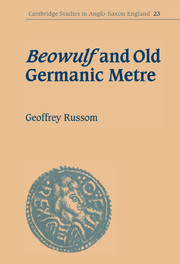Book contents
- Frontmatter
- Contents
- Preface
- List of abbreviation
- 1 Introduction
- 2 The foot
- 3 The verse
- 4 Light feet and extrametrical words
- 5 Metrical archaisms
- 6 Alliteration
- 7 Metrical subordination within the foot
- 8 Resolution
- 9 Word order and stress within the clause
- 10 Old Saxon alliterative verse
- 11 Hildebrandslied
- 12 Conclusions
- Appendix: Rule summary
- Bibliography
- Index
- Verses specially discussed
5 - Metrical archaisms
Published online by Cambridge University Press: 02 November 2009
- Frontmatter
- Contents
- Preface
- List of abbreviation
- 1 Introduction
- 2 The foot
- 3 The verse
- 4 Light feet and extrametrical words
- 5 Metrical archaisms
- 6 Alliteration
- 7 Metrical subordination within the foot
- 8 Resolution
- 9 Word order and stress within the clause
- 10 Old Saxon alliterative verse
- 11 Hildebrandslied
- 12 Conclusions
- Appendix: Rule summary
- Bibliography
- Index
- Verses specially discussed
Summary
An unmetrical verse in our Norse corpus often becomes perfectly regular when the scribal form of a word is replaced by an earlier form. Similar cases arise in Beowulf. The Old English poet evidently used older or newer phonological values of certain words according to metrical convenience. In some cases, the newer value would make the verse unmetrical; in others, the corresponding older value would do so. Variation of this sort does not seem to occur in native Eddie fornyrðislag. When metrical evidence points to an archaic value in one instance, there are no clear cases of the corresponding newer value elsewhere.
POSTCONSONANTAL RESONANTS AND VOWEL CONTRACTION
Variant Old English spellings testify to development of an epenthetic vowel before the postconsonantal resonants l, m, n, r in word-final position. Thus tācn ‘token’ has a variant spelling tācn. The Beowulf poet ordinarily uses such a word with its old monosyllabic value, but exploits the newer disyllabic value in some cases. Norse languages underwent a similar epenthesis (cf. ON maðr ‘man’, Modern Icelandic maður), but this took place after the date of the Codex Regius manuscript. Throughout our period of interest, Old Norse words like teikn ‘token’ were spelled as monosyllables and so treated in the syllable-counting skaldic metres.
- Type
- Chapter
- Information
- Beowulf and Old Germanic Metre , pp. 60 - 63Publisher: Cambridge University PressPrint publication year: 1998



